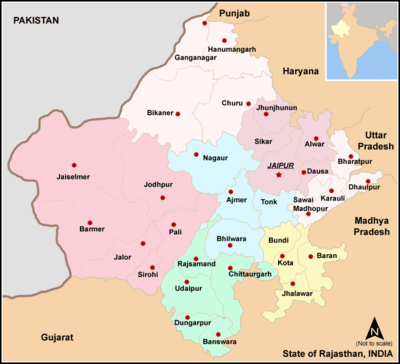Jangladesh
Jangladesh (Rajasthani: जन्ग्लादेश) also known as Jangal Pradesh was a historical region in north, north-western and north-eastern Rajasthan state in northern India.[1] It included the present-day districts of Bikaner, Churu, Ganganagar, and Hanumangarh. It was bounded on the south by Marwar and Jaisalmer regions, on the east by Ajmer-Merwara region.[2] There is mention of this province in Bhisma Parva of Mahabharata.[3]
| Historical Region of North India Jangal Desh (जन्ग्लादेश) | |
 | |
| Location | northern Rajasthan |
| State established: | 4th - 15th century |
| Language | Bagri |
| Dynasties | Jat |
It was bounded on the south by Marwar and Jaisalmer regions, on the east by Ajmer-Merwara region.[2] The region for centuries was an Abhira kingdom.[4][5]
History
There is mention of this province in Bhisma Parva of Mahabharata.[3] At what period the Jat people established themselves in the Indian desert is not known. By the 4th century they had spread up to Punjab in India.[6]
The north-eastern and north-western Rajasthan, known by the name Jangladesh in ancient times,[7] was inhabited by Jat clans ruled by their own chiefs and largely governed by their own customary law.[8] Besides these cantons there were several clan of Jat people, simultaneously wrested from Rajput proprietors for instance Bhukar, Bhadu, Chahar.[9] It is said about Jat territories that Saat Patti Sattavan Majh (means seven long and fifty-seven small territories).[10] Following are the main clans and their heads with capital and number of villages in each territory.,[11][12]
Table of Jat Kingdoms in Jangladesh:
| S.No. | Name of Kingdom | Name of King | No. of villages | Capital | Names of districts |
|---|---|---|---|---|---|
| 1. | Sihag | Chokha Singh | 150 | Suin | Rawatsar, Baramsar, Purabsar Dandusar, Gandaisi |
| 2. | Beniwal | Raisal Singh | 150 | Rasalana | Bhukarka, Sanduri, Manoharpur, Kooi, Bae |
| 3. | Johiya | Sher Singh | 600 | Bhurupal | Jaitpur, Kumanu, Mahajan, Peepasar, Udasar |
| 4. | Punia | Kanha Singh | 300 | Luddi | Bhadra, Ajitpura, Sidhmukh, Rajgarh, Dadrewa, Sankhoo |
| 5. | Saharan | Pula Singh | 300 | Bhadang | Khejra, Phoglo, Buchawas, Sui, Badnu, Sirsila |
| 6. | Godara | Pandu Singh | 700 | Shekhsar | Shekhsar, Pundrasar, Gusainsar (Bada), Gharsisar, Garibdesar, Rungaysar, Kalu |
| 7. | Kaswan | Kanwarpal Singh | 400 | Sidhmukh |
Most of Jat clans in Rajasthan had to accept Rathor's suzerainty in mughal times due to the rathores having made alliance with the mughals.,[2][13]
Other republics in Jangladesh
- Bhadu - Bhadus were rulers in Jangladesh where they established an important city Bhadra. Samantraj was a popular ruler of Bhadus. Bhadus had a war with 'Bhagore' people and after capturing it they moved to Marwar area. Bhadus also occupied many villages in Ajmer-Merwara.[14]
- Bhati - Jat Bhatis ruled Bhatner, presently Hanumangarh, and Bhatinda. Bhatner was historically important because it was situated on route of invaders from Central Asia to India.[15]
- Bhukar - Bhukars were initially settled at Sambhar in Rajasthan. They were the rulers in this area and their ruling method was that of 'Bhomia-chor'. Gothra Bhukaran was their capital.
- Chahar - In the thirteenth century, a Chahar Jat, Raja Maldeo ruled at Sidhmukh in Jangladesh.
- Jakhar - The king of the Jakhar clan, Jakhbhadra, settled in Jangladesh and made his capital at Reni (modern-day Taranagar).[16] At a later date, the Jakhars established a kingdom, the ruins of which are found at Madhauli, which was in the princely state of Jaipur.[16]
- Sangwan - The Sangwan jats ruled at Sarsu in Jangladesh region of Rajasthan in 8th to 10th century.
- Sahu - They have been the rulers of a small republic in Jangladesh. Their capital was at village Dhansia, situated at a distance of 65 km in northwest of Churu town.[17] There were 84 villages in their territory.,[11][18]
See also
References
- "Bikaner". Archived from the original on 19 August 2007. Retrieved 8 September 2007.
- Jibraeil: "Position of Jats in Churu Region", The Jats - Vol. II, Ed Dr Vir Singh, Delhi, 2006, p. 223
- Bhisma Parva On line
- Vīrasiṃha. The Jats: their role & contribution to the socio-economic life and polity of north & north-west India. Suraj Mal Memorial Education Society. Centre for Research and Publication (Originals). ISBN 978-81-88629-69-5.
- The Jats: their role & contribution to the socio-economic life and polity of north & north-west India, Volume 3-page-16
- Thakur Deshraj, Jat Itihas, 1934, p. 616-624
- Jibraeil: "Position of Jats in Churu Region", The Jats - Vol. II, Ed Dr Vir Singh, Delhi, 2006, p. 221-223
- Dashrath Sharma, Rajasthan through the ages, Jodhpur, 1966, Vol.I, p. 287-288
- Thakur Deshraj, Jat Itihas, Delhi, 2002, p. 269-285
- G.S.L.Devra, op. cit., Cf. Dayaldas ri Khyat, Part II, p. 7-10
- Jibraeil: "Position of Jats in Churu Region", The Jats - Vol. II, Ed Dr Vir Singh, Delhi, 2006, p. 222
- Dr Brahma Ram Chaudhary: The Jats - Vol. II, Ed Dr Vir Singh, Delhi, 2006, p. 250
- G.S.L. Devra, op. cit., 7-8, Cf. Dayaldas ri Khyat, part 2, p. 4-5
- Thakur Deshraj: Jat Itihas (Hindi), Delhi, 1934, p. 597
- Thakur Deshraj: Jat Itihas (Hindi), Delhi, 1934, p. 601
- Thakur Deshraj, Jat Itihas (Hindi), Maharaja Suraj Mal Smarak Shiksha Sansthan, Delhi, 1934, 2nd edition 1992 page 594-95.
- Dr.Mahendra Singh Arya, Dharmpal Singh Dudee, Kishan Singh Faujdar & Vijendra Singh Narwar (1998). आधुनिक जाट इतिहास [Ādhunik Jat Itihasa] (The modern history of Jats) (in Hindi). Agra: Jaypal Agencies. p. 282.CS1 maint: multiple names: authors list (link)
- GSL Devra, op. cit., Cf. Dayaldas ri Khyat, Part II, pp. 7-10